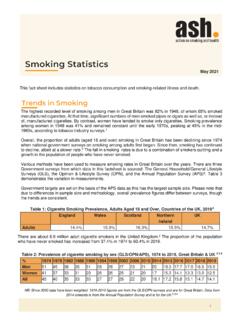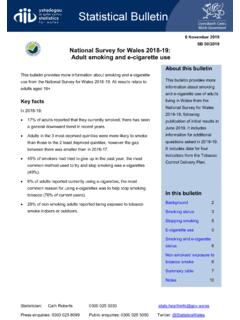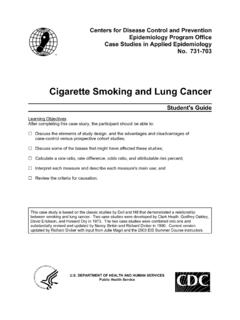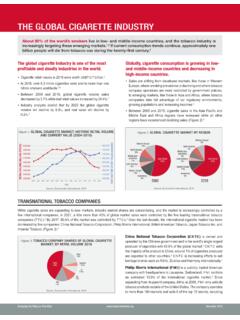Transcription of ENCOURAGING PEOPLE TO STOP SMOKING
1 WHO/MSD/ : EnglishDistr.: GeneralBEHAVIOURAL SCIENCELEARNING MODULESENCOURAGING PEOPLE TO STOP SMOKINGDEPARTMENT OF MENTAL HEALTH AND SUBSTANCE DEPENDENCE WORLD HEALTH ORGANIZATIONGENEVAF urther copies of this document may be obtained fromDepartment of Mental Health and Substance DependenceWorld Health Organization1211 Geneva 27 SwitzerlandCopyright World Health Organization [2001]This document is not a formal publication of the World Health Organization (WHO), and all rightsare reserved by the Organization. The document may, however, be freely reviewed, abstracted,reproduced or translated, in part or in whole, but not for sale or for use in conjunction withcommercial views expressed in documents by named authors are solely the responsibility of those STOPPING SMOKINGP refaceSmoking causes an enormous burden on public health. While policy measures to control tobaccouse are being applied all over the world, inadequate attention has been given to what the health careprofessionals can do in their routine work with patients.
2 The present document, EncouragingStopping SMOKING gives information on how medical professionals and health workers can increasethe likelihood of their patients stopping SMOKING . It also gives guidelines on this aspect beingincluded in medical and nursing training document has been developed by Dr Walsh and Professor Rob W. Sanson-Fisher ofAustralia, and WHO is indeed grateful to them for having undertaken this task. They have alsobeen responsible for incorporating many changes that were suggested by a series of reviewers,within and outside Stopping SMOKING is part of the Behavioural Science Learning Modules series of theWorld Health Organization (WHO). This series is aimed at providing behavioural scienceknowledge and skills to health care professionals to positively influence the health of their is hoped that the present document is useful tool for these professionals and their trainers.
3 Wewould be pleased to receive any feedback on the usefulness of this document and suggestions onhow to improve it. These suggestions may be sent to the reviewers have provided comments and suggestions. Of particular assistance were:Dr D. Rex Billington, Ms Jacqueline Chan-Kam, Ms Patsy Harrington, Dr Maristela G. Monteiro,Dr Pekka Puska, and Dr Martin Raw, Dr Suzanne Regional Office for Europe has assisted in reviewing this document and with its S. SaxenaCoordinatorMental Health Determinants and PopulationsDepartment of Mental Health andSubstance DependenceENCOURAGING STOPPING SMOKINGCONTENTSPAGEO verviewPART 1 Review of the nature of the problem .. 3- The facts - mortality and prevalence .. 3- Health 4- Benefits of stopping .. 7- Special targets - adolescents; 8 The clinician as an intervention 8 Doctors' current performance.
4 10 The potential of medical 11 How doctors can encourage 12 The role of nicotine replacement 16 The role of 19 Recommended steps in a medical intervention .. 19 Motivational intervention .. 31 Techniques to aid patient recall of information .. 31 PART 2 Guidelines for medical educators .. 32- Purpose .. 32- The materials .. 32- The 34 APPENDICESA ppendix 1 Sample case 38 Appendix 2 Rating scale for medical student 39 Appendix 3 The consequences of tobacco use: selected case 43 Appendix 4 Teaching cases: selected doctor-patient interactions .. 46 Appendix 5 Indirect intervention .. 55 ENCOURAGING STOPPING SMOKINGENCOURAGING STOPPING SMOKINGDr Raoul A. WalshSenior Research AcademicCancer Education Research Program (CERP)The Cancer Council New South WalesAustraliaProfessor Rob W. Sanson-FisherDean Faculty of Medicine and Health SciencesUniversity of NewcastleAustraliaPart 1 Learning objectivesUpon completion of this module, thestudent should be able to explain: The reasons for includingcounselling to stop SMOKING intoroutine medical practice; Cognitive, behavioural andpharmacological procedures usedto help PEOPLE to stop SMOKING ; How to tailor SMOKING cessationprogrammes to the patients stateof readiness to completion of the module thestudent should be able to: Incorporate SMOKING cessationefforts into normal medicalconsultations; Assess the patient s smokinghistory and willingness to try tostop SMOKING .
5 Deliver effective advice tailored tothe patient s needs and state ofreadiness and provide help andfollow-up; Prescribe nicotine replacementtherapy (NRT) module contains:Part 1 a review of the impact of SMOKING on public health and of the role of medicalprofessionals in the promotion of non- SMOKING . a detailed step-by-step approach that medical professionals and health workerscan adopt to increase the likelihood of their patients quitting 2 guidelines on the teaching and assessment in medical and nursing trainingprogrammes of techniques to encourage patients to stop STOPPING SMOKINGA review of the nature of theproblemOur aimThis manual is intended to help thehealth care professional to offereffective interventions for stoppingsmoking to patients during clinic professionals are uniquelysuited to the task of providing effectivesmoking cessation advice and supportto patients who do smoke, and millionsof smokers worldwide may beencouraged to quit SMOKING by theirhealth knowledge imparted is, inthe main.
6 Based on studies that aremore relevant to medical students andpractitioners in developed , with adaptation, theconcepts and approachesrecommended in the manual could beapplied in other educational particular, a number of the casespresented in Appendices 3 and 4 areclearly relevant to patients indeveloping the information included here isprimarily aimed at helping patientswho already smoke or use othertobacco products to stop, informationcan also be used to help preventtobacco use in the first place. Thelatter approach should indeed representthe most effective way to eliminatecompletely SMOKING -related diseases inthe long-term. However, theprevention of adolescent SMOKING hasproved a difficult challenge and it hasbeen argued that tackling adultsmoking may be the best way to reduceuptake in youth (Hill, 1999).
7 Therefore, efforts to help those whosmoke or use tobacco to stop doing sowill remain a vital component of anyhealth promotion programme. The textalso assumes that tobacco use ismainly through SMOKING many PEOPLE use tobacco inother forms such as cigars, pipes,chewing tobacco, pan masala, betelquid, Goza or Shisha, we have for thesake of clarity chosen to address onlycigarette SMOKING . However thedirections and concepts described inthis module can be applied to alltobacco users alike, regardless of theform their tobacco use factsCurrently tobacco products areestimated to be responsible for 3million deaths annually worldwide, orabout 6% of all deaths. But by the2020s or early 2030s, it is expected tocause of all deaths indeveloping countries and ofthose in developed countries, morethan any single statistics of tobacco-relatedmortality worldwide are is a known or probable causeof about 25 diseases; hence its impacton global disease is tremendous, if notyet fully appreciated.
8 It is estimatedthat there are approximately million smokers (47% of allmen and 12% of all women) in theworld, or about one-third of the globalpopulation aged 15 and over. The vastmajority of smokers are in developingcountries (800 million or over 70%),and most of them are men (700 millionor over 60%). This clearly suggeststhat SMOKING is a major problem indeveloping as well as developedcountries. In the light of the globalimpact of tobacco on human life, it isimperative that stronger measures betaken to persuade those who usetobacco to stop and to discourage thosewho do not smoke from 1990 Peto and Lopezestimated that about 40% of adults inChina, India, Indonesia and parts ofSouth America were current general, tobacco consumption isincreasing most rapidly amongst theENCOURAGING STOPPING SMOKING world s poorest countries, withparticularly dramatic increases incigarette consumption in Asia.
9 Duringthe period 1960 to 1980, cigaretteconsumption rose by 400% in Indiaand by 300% in Papua New Guinea(Taylor, 1989). The prevalence ofsmoking among persons aged 15 yearsor over in selected countries is outlinedin Table risksIt has been clearly shown that cigarettesmoking is a causal factor in thedevelopment of many serious medicalproblems, most notably cardiovasculardisease, cerebrovascular disease, lungcancer, and chronic obstructiveairways disease, as well as tumours ofthe mouth, larynx, oesophagus, lip andbladder. Other neoplastic andrespiratory causes of death, newbornand infant deaths due to maternalsmoking, cigarette-caused residentialfires and passive SMOKING deaths fromlung cancer are also substantialcomponents of tobacco-relatedmortality (US Department of Healthand Human Services, 1989).
10 Table 1 Estimated SMOKING prevalence among males and females aged 15 years andover in selected countries, percentagesMalesFemalesDeveloped CountriesAustraliaAustriaSwedenUnited KingdomUnited States of AmericaLess Developed CountriesArgentinaChinaIndia (10 areas)Korean RepublicThailandTurkey294222282840614068 4963212724262223737424 Tobacco or Health: A Global Status Health Organization: Geneva, 1997 ENCOURAGING STOPPING SMOKINGT able 2 illustrates the proportionsof ten selected causes of deathestimated to be attributable tosmoking in the USA. These data givean indication of the extent of specificdisease mortality caused by smokingespecially in developed nations. Theproportions of deaths in othercountries will be influenced by factorssuch as the prevalence of SMOKING ,types of cigarettes available andpatterns of 1 displays the estimatedrelative risks for SMOKING -relateddiseases of male and female smokerscompared to non-smokers.


















